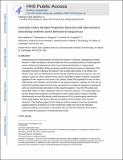| dc.contributor.author | Martiros, Nuné | |
| dc.contributor.author | Burgess, Alexandra A | |
| dc.contributor.author | Graybiel, Ann M | |
| dc.date.accessioned | 2022-07-12T16:22:53Z | |
| dc.date.available | 2021-10-27T20:10:06Z | |
| dc.date.available | 2022-07-12T16:22:53Z | |
| dc.date.issued | 2018 | |
| dc.identifier.uri | https://hdl.handle.net/1721.1/134967.2 | |
| dc.description.abstract | © 2018 Elsevier Ltd Understanding neural representations of behavioral routines is critical for understanding complex behavior in health and disease. We demonstrate here that accentuated activity of striatal projection neurons (SPNs) at the beginning and end of such behavioral repertoires is a supraordinate representation specifically marking previously rewarded behavioral sequences independent of the individual movements making up the behavior. We recorded spike activity in the striatum and primary motor cortex as individual rats learned specific rewarded lever-press sequences, each one unique to a given rat. Motor cortical neurons mainly responded in relation to specific movements regardless of their sequence of occurrence. By contrast, striatal SPN populations in each rat fired preferentially at the initiation and termination of its acquired sequence. Critically, the SPNs did not exhibit this bracketing signal when the same rats performed unreinforced sequences containing the same sub-movements that were present in their acquired sequence. Thus, the SPN activity was specifically related to a given repetitively reinforced movement sequence. This striatal beginning-and-end activity did not appear to be dependent on motor cortical inputs. However, strikingly, simultaneously recorded fast-spiking striatal interneurons (FSIs) showed equally selective but inverse firing patterns: they fired in between the initiation and termination of the acquired sequences. These findings suggest that the striatum contains networks of neurons representing acquired sequences of behavior at a level of abstraction higher than that of the individual movements making up the sequence. We propose that such SPN-FSI networks of the striatum could underlie the acquisition of chunked behavioral units. Habitual behavioral routines acquired by repetition are ubiquitous in daily life. Martiros et al. demonstrate that such learned habits and skills become marked as behavioral units, regardless of their movement content, by intrastriatal neuronal networks. After learning, this neuronal signal is not strongly dependent on motor cortex. | en_US |
| dc.language.iso | en | |
| dc.publisher | Elsevier BV | en_US |
| dc.relation.isversionof | 10.1016/J.CUB.2018.01.031 | en_US |
| dc.rights | Creative Commons Attribution-NonCommercial-NoDerivs License | en_US |
| dc.rights.uri | http://creativecommons.org/licenses/by-nc-nd/4.0/ | en_US |
| dc.source | PMC | en_US |
| dc.title | Inversely Active Striatal Projection Neurons and Interneurons Selectively Delimit Useful Behavioral Sequences | en_US |
| dc.type | Article | en_US |
| dc.contributor.department | McGovern Institute for Brain Research at MIT | en_US |
| dc.contributor.department | Massachusetts Institute of Technology. Department of Brain and Cognitive Sciences | en_US |
| dc.relation.journal | Current Biology | en_US |
| dc.eprint.version | Author's final manuscript | en_US |
| dc.type.uri | http://purl.org/eprint/type/JournalArticle | en_US |
| eprint.status | http://purl.org/eprint/status/PeerReviewed | en_US |
| dc.date.updated | 2019-10-01T17:53:42Z | |
| dspace.orderedauthors | Martiros, N; Burgess, AA; Graybiel, AM | en_US |
| dspace.date.submission | 2019-10-01T17:53:45Z | |
| mit.journal.volume | 28 | en_US |
| mit.journal.issue | 4 | en_US |
| mit.metadata.status | Publication Information Needed | en_US |
